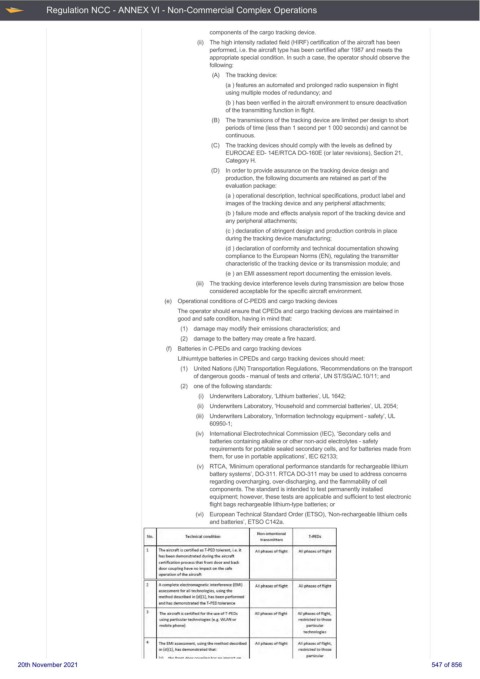Page 547 - UK Air Operations Regulations 201121
P. 547
~ Regulation NCC - ANNEX VI - Non-Commercial Complex Operations n trik
components of the cargo tracking device.
(ii) The high intensity radiated field (HIRF) certification of the aircraft has been
performed, i.e. the aircraft type has been certified after 1987 and meets the
appropriate special condition. In such a case, the operator should observe the
following:
(A) The tracking device:
(a ) features an automated and prolonged radio suspension in flight
using multiple modes of redundancy; and
(b ) has been verified in the aircraft environment to ensure deactivation
of the transmitting function in flight.
(B) The transmissions of the tracking device are limited per design to short
periods of time (less than 1 second per 1 000 seconds) and cannot be
continuous.
(C) The tracking devices should comply with the levels as defined by
EUROCAE ED- 14E/RTCA DO-160E (or later revisions), Section 21,
Category H.
(D) In order to provide assurance on the tracking device design and
production, the following documents are retained as part of the
evaluation package:
(a ) operational description, technical specifications, product label and
images of the tracking device and any peripheral attachments;
(b ) failure mode and effects analysis report of the tracking device and
any peripheral attachments;
(c ) declaration of stringent design and production controls in place
during the tracking device manufacturing;
(d ) declaration of conformity and technical documentation showing
compliance to the European Norms (EN), regulating the transmitter
characteristic of the tracking device or its transmission module; and
(e ) an EMI assessment report documenting the emission levels.
(iii) The tracking device interference levels during transmission are below those
considered acceptable for the specific aircraft environment.
(e) Operational conditions of C-PEDS and cargo tracking devices
The operator should ensure that CPEDs and cargo tracking devices are maintained in
good and safe condition, having in mind that:
(1) damage may modify their emissions characteristics; and
(2) damage to the battery may create a fire hazard.
(f) Batteries in C-PEDs and cargo tracking devices
Lithiumtype batteries in CPEDs and cargo tracking devices should meet:
(1) United Nations (UN) Transportation Regulations, ‘Recommendations on the transport
of dangerous goods - manual of tests and criteria’, UN ST/SG/AC.10/11; and
(2) one of the following standards:
(i) Underwriters Laboratory, ‘Lithium batteries’, UL 1642;
(ii) Underwriters Laboratory, ‘Household and commercial batteries’, UL 2054;
(iii) Underwriters Laboratory, ‘Information technology equipment - safety’, UL
60950-1;
(iv) International Electrotechnical Commission (IEC), ‘Secondary cells and
batteries containing alkaline or other non-acid electrolytes - safety
requirements for portable sealed secondary cells, and for batteries made from
them, for use in portable applications’, IEC 62133;
(v) RTCA, ‘Minimum operational performance standards for rechargeable lithium
battery systems’, DO-311. RTCA DO-311 may be used to address concerns
regarding overcharging, over-discharging, and the flammability of cell
components. The standard is intended to test permanently installed
equipment; however, these tests are applicable and sufficient to test electronic
flight bags rechargeable lithium-type batteries; or
(vi) European Technical Standard Order (ETSO), ‘Non-rechargeable lithium cells
and batteries’, ETSO C142a.
Non-intentional
No. T ec.hni-c:al condition T-PEDs
tran.sminers
1 The aircraft is certified as T-PED tole1ant, i.e. it
All phas.es of flight Al I phases of flight
has been demonstrated during the aircraft
certification process that front door and back
dOOI" coupling have no impact on the safe
op,eration of the aircraft
2 A complete electromagnetic interference (EMIi All phases of flight Al I phases of flight
assessment for all technologies, using the
methoo described in (d){11, has been performed
and has demonstrated the T-PED t oleraoce
3
The aircraft is certified for the use of T-PE.Ds All phases of flight All ptlases of flight,
using particular technologies (e.g.. WlAN or restricted to those
mobile phone) particular
technologies
4 The EMJ assessment, using the method described All phases of flight All phases of flight,
in (d j(ll, has demonstrated that: restricted to those
particular
,,, o-h .. ~....+ ..l""r ,....,,, , ... ion ... h,.., ~ ;_.,,,,.,-+ "'"
20th November 2021 547 of 856

